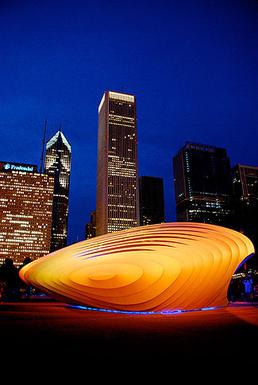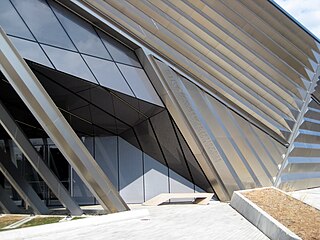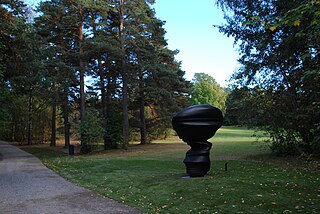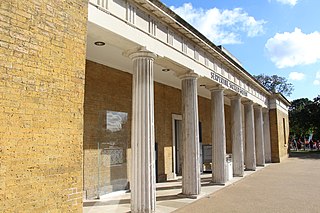
The Marble Arch is a 19th-century white marble-faced triumphal arch in London, England. The structure was designed by John Nash in 1827 as the state entrance to the cour d'honneur of Buckingham Palace; it stood near the site of what is today the three-bayed, central projection of the palace containing the well-known balcony. In 1851, on the initiative of architect and urban planner Decimus Burton, a one-time pupil of John Nash, the arch was relocated to its current site, near the northeast corner of Hyde Park, so that expansion of Buckingham Palace could proceed.

Dame Zaha Mohammad Hadid was an Iraqi architect, artist and designer, recognized as a major figure in architecture of the late-20th and early-21st centuries. Born in Baghdad, Iraq, Hadid studied mathematics as an undergraduate and then enrolled at the Architectural Association School of Architecture in 1972. In search of an alternative system to traditional architectural drawing, and influenced by Suprematism and the Russian avant-garde, Hadid adopted painting as a design tool and abstraction as an investigative principle to "reinvestigate the aborted and untested experiments of Modernism [...] to unveil new fields of building".

The Serpentine Galleries are two contemporary art galleries in Kensington Gardens, Westminster, Greater London. Recently rebranded to just Serpentine, the organisation is split across Serpentine South, previously known as the Serpentine Gallery, and Serpentine North, previously known as the Sackler Gallery. The gallery spaces are within five minutes' walk of each other, linked by the bridge over the Serpentine Lake from which the galleries get their names. Their exhibitions, architecture, education and public programmes attract up to 1.2 million visitors a year. Admission to both galleries is free. The CEO is Bettina Korek, and the artistic director Hans Ulrich Obrist.

Maggie's centres are a network of drop-in centres across the United Kingdom and Hong Kong, which aim to help anyone who has been affected by cancer. They are not intended as a replacement for conventional cancer therapy, but as a caring environment that can provide support, information and practical advice. They are located near, but are detached from, existing NHS hospitals.

Cardiff Bay Opera House was a proposed centre for the performing arts in Cardiff Bay, Cardiff, Wales, conceived in the 1990s as a crucial part of the Cardiff Bay redevelopment project. One aim of the scheme was to create a new home for the Welsh National Opera company, which was then based in the New Theatre in Cardiff. The Wales Millennium Centre was built in its place and it opened in 2004.

Neo-futurism is a late-20th to early-21st-century movement in the arts, design, and architecture.
Dame Julia Peyton-Jones is a British curator and gallery director, currently Senior Global Director at Galerie Thaddaeus Ropac in London, Paris and Salzburg. She formerly worked as Co-Director of the Serpentine Gallery in London.

Dongdaemun Design Plaza is a major urban development landmark in Seoul, South Korea, designed by Zaha Hadid and Samoo, with a distinctively neofuturistic design characterized by the "powerful, curving forms of elongated structures." The landmark is the centerpiece of South Korea's fashion hub and popular tourist destination, Dongdaemun, featuring a walkable park on its roofs, large global exhibition spaces, futuristic retail stores, and restored parts of the Seoul fortress.

CityLife is a residential, commercial and business district situated a short distance from the old city centre of Milan, Italy; it has an area of 36.6 hectares. It is a redevelopment project on the former grounds of Fiera Milano after its relocation to the nearby town of Rho.

The Riverside Museum is a museum in the Yorkhill area of Glasgow, Scotland, housed in a building designed by Zaha Hadid Architects, with its River Clyde frontage at the new Pointhouse Quay. It forms part of the Glasgow Harbour regeneration project. The building opened in June 2011, winning the 2013 European Museum of the Year Award. It houses many exhibits of national and international importance. The Govan-Partick Bridge, which will provide a pedestrian and cycle path link from the museum across the Clyde to Govan, is set to be completed in 2024.

The Burnham Pavilions were public sculptures by Zaha Hadid and Ben van Berkel in Millennium Park, which were located in the Loop community area of Chicago, Illinois. Both pavilions were located in the Chase Promenade South. Their purpose was to commemorate the 100th anniversary of Daniel Burnham's Plan of Chicago, and symbolize the city's continued pursuit of the Plan's architectural vision with contemporary architecture and planning. The sculptures were privately funded and reside in Millennium Park. The pavilions were designed to be temporary structures.

Mandarin Oriental Hyde Park, London, is a five-star hotel, located in the Knightsbridge area of London, owned and managed by Mandarin Oriental Hotel Group. Housed in a historic, Edwardian-style building, the hotel originally opened in 1908 as the Hyde Park Hotel and in 1996 the Mandarin Oriental Hotel Group purchased the property and conducted a full renovation, consequently re-opening in May 2000.

The Eli and Edythe Broad Art Museum is a nonprofit, contemporary art museum designed by Zaha Hadid located on the campus of Michigan State University in East Lansing, Michigan, United States. It opened on November 10, 2012.
Zaha Hadid Architects is a British architecture and design firm founded by Zaha Hadid (1950–2016), with its main office situated in Clerkenwell, London. After the death of "starchitect" Hadid, Patrik Schumacher became head of the firm, at the time with a staff of 400 with 36 projects across 21 countries.

Ekebergparken Sculpture Park is a sculpture park and a national heritage park close to Ekebergrestauranten with a panoramic view of the city at Ekeberg in the southeast of the city of Oslo, Norway.

The Hayward Gallery is an art gallery within the Southbank Centre in central London, England and part of an area of major arts venues on the South Bank of the River Thames. It is sited adjacent to the other Southbank Centre buildings and also the National Theatre and BFI Southbank repertory cinema. Following a rebranding of the South Bank Centre to Southbank Centre in early 2007, the Hayward Gallery was known as the Hayward until early 2011.

The 7 July Memorial is a permanent memorial to the 52 victims of the 7 July 2005 London bombings. It is located on the east side of Hyde Park, between Lover's Walk and Park Lane, close to Curzon Gate and about 150 metres (490 ft) north of the monumental statue of Achilles.

The Cavalry of the Empire Memorial, also known as the Cavalry Memorial, is a war memorial in Hyde Park, London. It commemorates the service of cavalry regiments in the First and Second World Wars. It became a Grade II listed building in 1987, and was promoted to Grade II* in November 2014.

The Registrar-General's building, also called the Land Titles Office, is a heritage-listed building located in the Sydney central business district, in New South Wales, Australia. The building is currently used by the Land and Property Information division of the Department of Finance, Services and Innovation, part of the Government of New South Wales. It was added to the New South Wales State Heritage Register on 2 April 1999.

Serpentine North or Serpentine North Gallery is a listed building in Hyde Park, London, which, with the South Gallery, constitutes the Serpentine Galleries, an art exposition space. It was originally known as The Magazine, and also, from 2013 to 2021, as the Serpentine Sackler Gallery. Since 2013, the name The Magazine specifically refers to an extension of the building, a restaurant designed by architect Zaha Hadid.




















